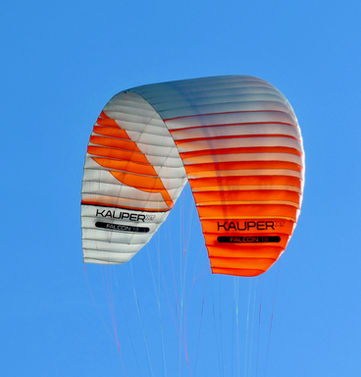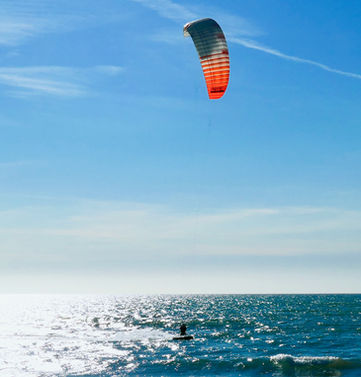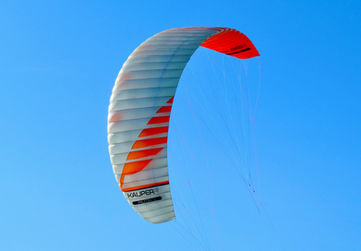


MY ULTRALIGHT FOILKITE V3

WEIGHT & SIZES


All weights are approximate.
ULTRALIGHT - EFFICIENT - AGILE

Ultralight
With the Falcon everything was realized that does NOT make a kite heavy. Starting with the choice of cloth, countless crossports wherever possible without impairing the stability at the same time, right up to the design of the bridle. Every little detail has been developed separately. All in all only this procedure results in a really ultra-light kite. The Falcon thus advances into areas that otherwise only single-skin kites claim for themselves. How exactly this weight advantage was achieved with the Falcon I will explain and describe here soon.
Efficient
I always expect good performance from a foil kite. More precisely this means the start of planing and gliding through, upwind performance, hangtime and depower range. With the Falcon these properties are primarily achieved through its special reflex profile and its low weight. The outline and the arc one hand follow the requirement to achieve a good performance, but on the other hand also have a very easy handling. Good performance and easy handling are together the efficiency that my foilkite has to combine. All information on this will also be provided soon.


Agile
I've never liked a sluggish kite. It was the same with my LEI-kites and it is the same with my foilkite. The Falcon is very agile for a foil kite and in no way limits me on the foil. It invites you to try new tricks all the time. I really enjoy its high flying speed and in combination with its agility it allows you to get extra performance out of the kite. The brake allows various adjustment options so that the Falcon can be adapted to your own riding style. A new feature of the Falcon-III is the significantly better acceleration, which is immediately noticeable.
FEATURES
The primary goal when developing the Falcon-III was to get a kite that is as uncomplicated as possible with the highest possible performance and easy handling.
Shape
The Falcon is an intermediate foil kite with an average aspect ratio of 5.6 at 13m size. It is slightly higher than the two previous models. On one hand this means slightly higher performance, which is easy to access at all times. On the other hand the relatively high number of cells (39) ensures a clean profile and also has a positive effect on the performance of the new Falcon. Those who switch from a tube kite to a foil kite have no problems, or even long periods of getting used to it. This shape with enough area at the wing tips ensures that the kite turns very agile, but also that the wingtips always stay open and no flaps occur.


Load Bearing
Right from the start the Falcon was set up very differently than is usual with foil kites. Here the upper and lower sails no longer take on a load-bearing function, but are only the shell and only create the aerodynamic shape of the kite. All loads go from the bridle lines directly to the ribs, internal span-wise straps and V-tapes. When calculating the loads and the resulting design of the materials this approach opened up completely new possibilities. This decoupling of the functions enables a much lighter construction because the loads are only concentrated in those areas in the kite where materials are used that can sustain high loads. The otherwise unavoidable compromise between weight and strength is completely eliminated. Each individual component in the kite can therefore be designed much more precisely and purposefully. However it must also be clear that such a weight-optimized construction can lead to breakage if overloaded. With lightweight foil kites it is customary and compulsory for the kiter to pay special attention. At the Falcon-III the tension tapes were not made from hard-finish cloth for the first time, but from webbing, which has significantly better strength values.
Depower / Barfeeling
Foil kites are often said to have to walk to the edge of the wind window in order to create a depower effect. This is completely different with the Falcon. The kite behaves very similarly to a tube kite. Slack in the bar creates an immediate slack in the pull. This behavior is generated by a special reflex profile. When you release the bar the entire kite only hangs on the A-lines and blows out freely. It is precisely this feature that has now been significantly improved in the Falcon-III. This profile and the suspension also create a moment in the kite that keeps it upright when the angle of attack has become too small, for example due to strong wind shifts or gusts. When designing the Falcon it was also very important to me to get an absolutely direct bar feeling. A spongy back and forth at the bar gives me no contact to the kite. The holding and steering forces are therefore very close to that of tube kites.


Relaunch
It is well known that foil kites can be launched backwards using both backlines in extremely low winds. This technique works in a windrange of around 3kn if you have practiced it beforehand. The special thing about the Falcon however is that it can be relaunched with just one backline quite similar to tube kites. In some situations this is much faster and easier. The shape and the bridle setup of the Falcon make this feature possible.
Bridle
With a foil kite the bridle determines the entire characteristics of the kite. Because of its reflex profile the Falcon has the highest tensile forces on the A-lines, a little less on the B-lines, etc. It also clear that higher loads occur in the middle of the kite than at the wing tips. The line strengths in the bridle should therefore always be designed accordingly so that stronger lines can be found where high loads have to be carried. The illustration on the right uses the A-line level as an example to show which lines are used where. You can clearly see how many different types of lines are used. Very thin lines were used in order to generate as little air resistance as possible. Nevertheless we made a very conscious decision to use sheathed lines (Liros PPSLS) for the main carrying lines. This significantly minimizes the change in length of the lines during kite sessions, because no sand, salt, etc. can penetrate the line and thus almost no shortening occurs. Trimming is therefore only very rarely necessary. The top lines (the lines directly on the lower sail) are uncovered lines (Liros DC). There are only very few tensile loads on the respective line and these lines are only short in length, which means that only a very small change in length could result from this. The respective line levels are color-coded in the Falcon and make it easier to get an overview:
A = red; B = yellow; C = blue; Z = orange.

DESIGN-TEAM
The Falcon is a joint development by Ernst Strobl and me. Ernst is a real number in paragliding. Successful in sport as vice world champion and head designer at U-Turn and various other labels for many years his abilities are undisputed. After so many years of friendship we were just totally excited to start a project together. The first ideas started in autumn 2019 and since then this kite has not let us go.


DNA
In principle the Falcon had the same requirements as my LEI-kites during development. It should have a good performance, but this must be very easy to access. It has to inflate with air quickly and be completely problem-free during the relaunch even if there is very little wind and therefore takes longer. This relaunch should also only be possible by pulling on one backline similar to tube kites. Of course I would like to have the pressure build-up on my foil kite very directly, but it should never overwhelm me, let alone stress me. I would much rather concentrate on foiling instead of having to open the folded wing tips again while riding. The two most important points for me were definitely an extremely low weight of the entire kite and a very direct depower effect which I usually only have with tube kites. A very high agility was a must anyway otherwise the kite would not be fun at all for me. Ernst and I are more than satisfied with the result.

CONSTRUCTION
“The requirement to develop an ultra-light foil kite is not simply done by using very light canopy material. Only the construction details make the difference and result in a light yet stable kite“

Materials
In order to build a closed-cell foil kite as light as is the case with the Falcon there is no way around ultra-light canopy materials. Ernst has many years of experience with his paragliders and that's why we decided on the new Paratex Evolution material, developped in 2021. This material is highly coated with silicone on both sides. It therefore takes almost no water at all, but requires specially trained sewers in the production. The special feature of the ripstop fabric which weighs only 32 g/sqm is its extremely longlife high airtightness which puts other materials in the shade. This guarantees a high profile accuracy even after many hours on the water.
Aerodynamics
Foil kites often look like crumpled duvets after a long night. The leading edge in particular often dents and has no tension. From an aerodynamic point of view such a kite is certainly not optimal. With the Falcon aerodynamics were one of the most important points for us. The kite should stand in the sky like a wing and have a dent-free leading edge with a lot of tension. A lot of experience and know-how in the area of pre-tensioning for paragliders and foil kites is required to achieve this goal. If the kite is pretensioned too much you will get a tight leading edge, but it also tends to stall / backstall and the opposite behavior if there is too little tension. The picture on the right shows how clean a foil kite can look if the tech. design is right. A new feature of the Falcon-III is the modified reflex profile, which makes the kite even more agile and nimble.


Ballooning
The inflation of the cells in the foil kite is caused by the internal air pressure and is generally referred as ballooning. The goal of a kite designer is to control this ballooning as far as possible over the entire profile length and span. This is done by pretensioning on the upper and lower sail. If these specifications do not harmonize with each other, folds and in the worst case aerodynamically unfavorable dents appear. Very elaborate cuts in the 3D on the panels result in a aerodynamically efficient profile on the leading edge and create a sharp trailing edge. The decoupling of the upper and lower sail from the V-tapes and span-wise straps is very important. This is the only way that the kite maintains its ballooning and thus also its internal pressure conditions even when it is completely depowered.
Internal Construction
A light foil kite only makes sense if the internal construction is also very light, but still robust to withstand intensive kite sessions. This includes not only very exactly cut-out elliptical crossports (holes) in the ribs, but also span-wise straps and V-tapes with a hem in order to be able to take significantly more load. This hem is only 5mm wide and requires the highest precision from the sewers. All tension tapes are now made of real webbing and keep the kite even better in shape. Similar to the ribs the V-Tapes have holes cut out to save additional weight. So that the brake is particularly effective and creates agile flight characterictics the crossports are arranged in the ribs in such a way that there is a precisely defined kink point in the profile.


LE Profile Reinforcements
In modern foil kites so-called LE profile reinforcements are used along the leading edge. Until now these have always been thin plastic rods that ensure a stable profile. In the new Falcon-III these are now made of Nitinol. The material chosen for the rods is a special metal that allows an extremely tight packing of the kite and even after months in the kite bag the rods correctly support the given profile of the kite. You can even tie a knot in the rods and they immediately return to their original shape after the knot is undone. The pockets for the rods on the ribs are very elaborately manufactured so that the kite does not damage even with hard contact on the leading edge.
Ribs
The ribs in the Falcon must take up a majority of the loads in the kite. That is why they are made from hard-finish cloth. This cloth can take significantly higher loads, but has the disadvantage that it is much heavier than the Paratex for the upper and lower sail. In order to still get a very light kite the ribs are provided with elliptical crossports (holes) to save weight. These crossports are arranged in such a way that the static in the kite is not reduced. In order to save further weight all ribs of the Falcon where bridle lines attack are made of 38 gr. cloth. All ribs without bridle points are only made of 32 gr. cloth see pink lines at the picture. A higher effort for production, but a very good means of obtaining a really ultra-light kite.


Attachment Points
The newly developed Paratex cloth gives the Falcon II even more agility and a more direct riding experience. In order to transfer this directly to the bar the attachment points of the bridle lines must also be adapted to these requirements. The new construction with webbing is additionally reinforced at the points where the highest load can occur see blue points in the picture on the left. As a result the tensile forces are introduced into the ribs even wider. All other points are weight-optimized.
Deflation Valve
In order to be able to deflate the Falcon as quickly as possible after kiting we have now opted for a single opening in the center of the trailing edge of the Falcon-III. The amount of air that can escape when the valves are open is very large and allows the kite to be packed quickly. The valve can be closed and opened with Velcro. A tube made of white spinnaker cloth prevents it from closing itself when the air is deflated. Two small flags make it easier to open the Velcro. Another small Velcro is fixing the flying lines and bridle system when packing the kite.


Kite Trim
With a foil kite the trim of the kite changes in the course of kite sessions by changing the lengths of the bridle lines. In the case of the Falcon this is significantly minimized through the use of sheathed lines. However should trimming be necessary, the mixer can be adjusted correctly again separately and completely independently by using the B, C and brake lines. The trim can also be checked using the knots in the wagon lines (long mixer test).
Kite-Bag
A light kite needs a light kite bag. With only 135 gr this bag is really light and fits well for traveling. It is simple, functional and nevertheless solid. No needless details and just the focus on the essentials. A bag how I have always wanted to have. The two side lines close the opening at the top of the bag and also serve as a shoulder strap. Because the Falcon and the bag are so light no padding is needed here.

TECHN.DATA

The wind range table should only be used as a rough guide for a rider with 75kg weight. Please choose the size of your kite according to your own body weight, water / land use, as well as the board size and type (small TT or foil). Use your own experience and your responsible mind as a guide. All weights are approximate.
MOMENTS
KEYPOINTS
Colors

Orange / Light Grey

All prices include VAT plus shipping costs. All weights are approximate.
In accordance with the distance selling regulation for cross-border deliveries of goods to private individuals that will apply in the EU from July 1st, 2021the VAT rate of the destination country is calculated.



















